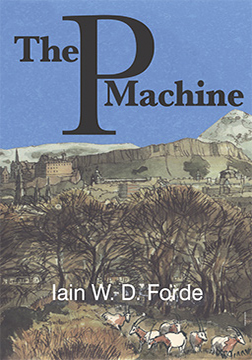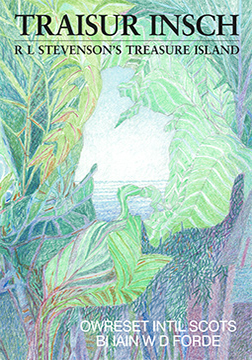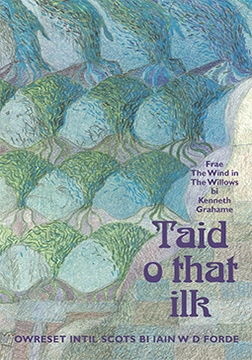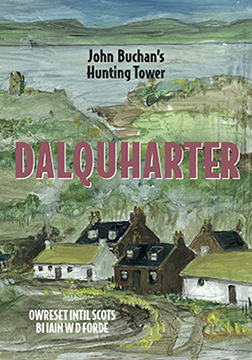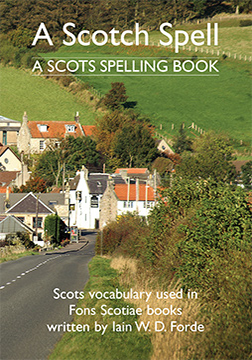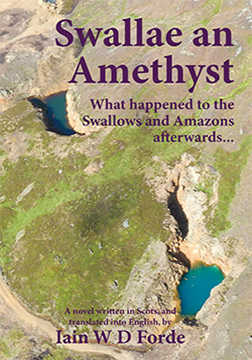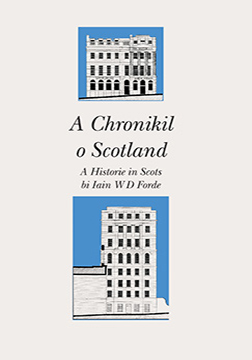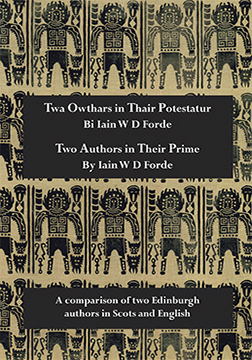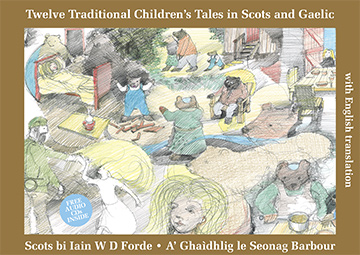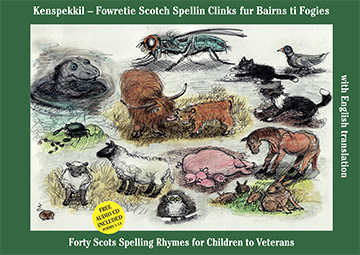Traisur Insch
Robert Louis Stevenson’s “Treasure Island” owreset intil Scots bi Iain WD Forde © 2008.
Robert Louis Stevenson hed a guid Scots tung in hiz heid an endytit a nummer o stores in the leid. Gif Scotland’s langage hedna bene sae disjaskit he mote wrate i braid Scots lik this owreset contenes, aye inhauddin the ryke thesaur o wirds frae auld lang syne.
Drauchtins bi the owthar. Borde an cairte bi Mick Duncan.
Treasure Island
Robert Louis Stevenson’s “Treasure Island” owreset intil Scots bi Iain WD Forde © 2008.
Robert Louis Stevenson hed a guid Scots tung in hiz heid an endytit a nummer o stores in the leid. Gif Scotland’s langage hedna bene sae disjaskit he mote wrate i braid Scots lik this owreset contenes, aye inhauddin the ryke thesaur o wirds frae auld lang syne.
Drauchtins bi the owthar. Borde an cairte bi Mick Duncan.


Walcum
The purposs o Fons Scotiae is ti propale the ettils o Iain W D Forde ti uise the Scots Tung lik it aye bene the modren naitiounal langage – guid braid Scots.
Scots is the langage o the Laichlauns o Scotland, foundit on the Angliane tung brocht ti the Bret Eyles frae Nor Europ bi the incummers eftir the Roumans gaed hame. Scots alse hes kell-heids frae the kintraes at neipour hir – Eire; the Norse kintraes; Fraince; the Laich Kintraes; an Ingland. Lik aw langages Scots hes daialeks at ir unnerstuid bi ilkane Scots speiker. Scots rase ti be the cheif langage o the Scotch Court; o the Kirk; o leiteratur, an o the lede, in the centures afoir the Uinioun o the Crouns in eir 1603, bot syne it wure awaw. In speik, sang an poesie Scots is aye ti the foir. Furmal pross hes devaulit, an mote be restaurit.
Welcome
The purpose of Fons Scotiae is the publication of Iain W D Forde’s venture to use Scots as if it had continued as the modern national language – ‘guid braid Scots’.
Scots is the language of Lowland Scotland, based on the Anglian tongue brought to the British Isles from northern Europe by the post-Roman immigrants. Scots is also sourced from the countries that are her neighbours – Ireland; the Scandinavian countries; France; the Netherlands and England. Like all languages Scots has dialects which are mutually intelligible. Scots rose to be the chief language of the Scottish Court; of the Church; of literature; and of the people, in the centuries before the Union of the Crowns in 1603, after which it declined. In speech, song and poetry Scots survives. Formal Scots prose has declined and needs to be restored.
The Paix Machine
A buik in Scots bi Iain WD Forde
© 1996
This wes the erest modren novelle i Scots, wrate ti plenish wi growen-buddie pross thur at kent the langage awreddies, an fuither studiands o the leid.
The owrecum o’t is the moyen at outby polatie hes on a tung an upo the fowk at speik it, an the sair darg at is note ti redd up the efterins.
Buird an drauchtins bi the owthar.
A book in Scots by Iain WD Forde
© 1996
This was the first modern novel in Scots, written to provide adult prose for those who knew the language already, and for future students of the tongue.
Its theme is the influence that external culture has on a language and upon the people who speak it; and the hard work that is needed to clear up the after effects.
Cover design and illustrations by the author.
Hale ir Sindries
A buik in Scots bi Iain WD Forde ©1999
This is a marra ti ‘The Paix Machine’ at wes propaled bi the owther in yeir 1999. Lik its preceder. ‘Hale Ir Sindries’ is wrate i hale-heidit Scots, an ettils ti stent the skowth o the leid.
A novelle inhaudden thrie buiks, pairt ain-weird, bot wi a smell o gallus aventur.
Buird an drauchtins bi the owthar.
A book in Scots by Iain WD Forde
© 1999
This a companion to ‘The Paix Machine’ which was published by the author in 1999. Like its predecessor ‘Hale Ir Sindries’ is written in whole-hearted Scots, and aims to extend the scope of the language.
A novel in three parts, part autobiography, but with a dash of ‘ripping yarn’.
Cover design and illustrations by the author.
The Kirk, The Skuil, The Buik
A buik in Scots bi Iain WD Forde
© 2007
This buik is the lest o the thriesum, an tels whitlik happent ti the ither warks, furby the weird o the antient ordinateir, Napier, at gyed the twenes in ‘The Paix Machine’ an wes thocht ti be deid in ‘Hale Ir Sindries’. Bot it isna said, fur the’r a whein lauchs an baurs intil the peges an aw.
A book in Scots by Iain WD Forde
© 2007
This book is the last of the trilogy, and tells what happened to the other books, and the fate of the ancient computer, Napier, who guided the twins in ‘The Paix Machine’, and was thought to be dead in ‘Hale Ir Sindries’. But it isn’t sad, for there are some laughs and jokes within the pages also.
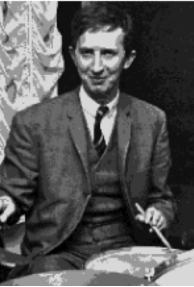
The Owthar
The owthar wes at a skuil in Embro whaur Sots wes techeit bot no alloued in the pleygrun, i conter ti the uiswal setivautioun. He follaed the prattik o airchitek in Embro aw hiz leivin days ontil reteirin ti wryte. Nou at the kintra o Scotland is muivin slawlie ti friedome he howps ti sei the day whan the Scotch langage is alse lowsed frae its cheins.
The Author
The author was at a school in Edinburgh where Scots was taught but not allowed in the playground, contrary to the usual situation. He followed the profession of architecture in Edinburgh all his working life until retiring to write. Now that the nation of Scotland is moving slowly towards freedom he hopes to see the day when the Scots language is also loosed from its chains.
To find further information about each book ISBN etc hover over the cover graphic of each book.
To read an extract from each book click on the Scots title just under each book cover.
Taid o that Ilk
The Adventurs o Taid frae “The Wind in the Willows” bi Kenneth Grahame owrest intil Scots bi Iain W D Forde © 2009.
Kenneth Grahame cam hame in Embro bot gaed ti byde wi hiz faimlie in Argyll whan he wes fowre eir auld ontil he wes seiven. He sayed, “The part of my brain that I used then can never be altered.”
Eftir hiz mither died he gaed ti byde wi hiz Grannie in Ingland. Eftir cumin spede in hiz publict skuil he wes pit ti wirk in the Baunk o Ingland, no the Uinivarsitie o Oxfuird whaur he ettilt ti gang. Thur monie sair kunks clekkit hiz endytes. Wiout thaim mibbies he wuid nivver wrate. Aiblins gif he hed stayed in Scotland “Taid o that Ilk” cuid bene steidit on the bonie Crinan Canaul.
“Taid o that Ilk” hips the cheptours o “The Wind in the Willows” at dinna hae mukkil ti dae wi Taid.
Drauchtins by the owthar. Batters desing by Mick Duncan.
Toad of Toad Hall
The Adventures of Toad from “The Wind in the Willows” by Kenneth Grahame translated into Scots by Iain W D Forde © 2009.
Kenneth Grahame was born in Edinburgh but went to live in Argyll with his family when he was four years old until he was seven. He said “The part of my brain that I used then can never be altered.”
After his mother died he went to live with his grandmother in England. Though a success at his public school he wa sent to work in the Bank of Scotland, not Oxford University where he wished to go. These disappointments were the source of his writings. Without them he might never have writeen. Perhaps if he had remained in Scotland “Taid o that Ilk” could have been based around the beautiful Crinan Canal.
“Taid o that Ilk” skips the chapters in “The Wind in the Willows” which do not have much to do with Toad.
Illustrations by the author. Cover design by Mick Duncan.
Dalquharter
John Buchan wes a cheil frae Perth, an wes the foirmaist exempil o a ‘lad o pairts’. Educat at Glesca an Oxenfuird Colleges, a Memmer o Perlament, lawer, Gydar o a prentar – Nelson’s – an at the hinner en the Gouvernour-Generall o Canada, wi the teitil o Baron Tweidsmuir. Furby he wrate a guid hantil o buiks o adventur, biographie and histore, nae dout halped bi the wirk he duin durand the First Warl Weir, as a Gydar o Infurmautioun in the Sairvices.
Evin tho he duin aw thon, he endytit vairse in Scots, an monie o his caracts in the novelles spak Scots. Gif he hedna darged fur the Bret Impyre he mote a wrate mair in Scots, an mebbies ‘Huntingtower’ wuid a adoppit the langage o hiz cauf kintra, Scots, an luiked a bittie lik this buik.
Huntingtower
John Buchan came from Perth, and was an outstanding example of the ‘lad o pairts’. Educated at Glasgow and Oxford Universities, a Member of Parliament, a lawyer, Director of a printing house – Nelson’s – and eventually the Governor-General of Canada, with the title of Baron Tweedsmuir.
He also wrote a good number of books of adventure, biography and history, no doubt helped by the work he did during the First World War as Director of Information in the Services.
As well as all this, he wrote poetry in Scots and many of his characters in the novels spoke Scots. If he had not worked for the British Empire he might have written more in Scots, and maybe ‘Huntingtower’ would have adopted the language of his native country, Scots, and looked something like this book.
A Scotch Spell – A Scots Spelling Book
This is a useful handbook for people interested in writing and reading the Scots language. It has:
a record of the integrated spelling that is used by Fons Scotiae’s publications of Iain WD Forde’s writings
in Scots
A list of over 8,700 Scots words and phrases; explanations of phonetics, language history etc; nautical words and phrases from ‘Traisur Insch’; domestic terms and early motoring from ‘Taid o That Ilk’; specialist vocabulary for modern art, the weather, economics, history, warfare and nature from ‘The Kirk, The Skuil, The Buik’.
The books, written over the last 25 years, include three original works - novels with poetry and essays; and three translations of classics written by Scottish authors.
After the Crown and Parliament moved from Edinburgh to London Scots became a language for speech, poetry and song, and there was little prose written. Each area developed its own dialect of Scots – from Shetlandic to Doric to Ulster Scots - so that, although these dialects are mutually comprehensible, pronunciation varied, and so did spelling. ‘The Concise Scots Dictionary’ records many of these spellings.
As there is no standardised or agreed spelling of Scots yet anyone wishing to write in Scots prose, especially formal prose, has to decide which of the many possible spellings to use; and has to keep a record, to have a personal consistency. ‘A Scotch Spell – A Scots Spelling Book’ is just such a record list.
* A more detailed history of the development of the Scots language, and its cousin English can be found in the Forward/Foirwart to the book.
Twelve Traditional Children’s Tales
in Scots and Gaelic with English translation
including 2 CDs in Scots and Gaelic
The historic languages of Scotland are Gaelic, Scots and English. Gaelic came from Ireland about 500AD, becoming the main tongue while the country was being formed from the various Celtic peoples. Scots developed from the North Anglian and Scandinavian tongues that arrived from Europe, starting about the same time as, but taking over from Gaelic as the language of resistance during the Wars of Independence. Latin was the main international language of those times, as English is now.
These Children’s Stories are translated into, and read in Gaelic by Seonag Barbour. Born in Valtos in Skye she is a native speaker, schooled locally and in Portree, Skye, then at Glasgow University (History and Celtic Studies). She taught in Barra and elsewhere, and at the Gaelic College at Sleat in Skye, and is now farming in Perthshire where she is also bringing up her burgeoning family.
The stories are in Scots and translated into English by Iain W D Forde, who was educated in Edinburgh and practised as an architect there. Now retired he writes in Scots but not being a native speaker he has arranged for the stories to be recorded on the accompanying CDs by Norrie Thomson assisted by his grandson Gregor. The former Customs Officer from Edinburgh also produced the recordings.
This book is published by Fons Scotiae, administered by Susan F G Forde, another Edinburgh citizen, Honours Graduate of Edinburgh University. Drawings - these have been done by Iain W D Forde who hopes that children may be encouraged to colour them in.
Kenspekkil
Forty Scots Spelling Rhymes for Children and Veterans
including 2 CDs in Scots and Gaelic
Each rhyme illustrates one of the distinctive vowel, or consonant, or combination of these sounds available in Scots. Rhymes are particularly suitable for this purpose.
First fourteen rhymes read in Scots by Norrie and Gregor Thomson. Each rhyme has an English translation which is not itself in rhyme.
The first seven are set out and illustrated in such a manner that a teacher or parent can easily read the rhymes on the reverse while the pupils see the illustrated front of the page which includes a simple game for children to play. Equally, adults not knowing Scots at all can enter the language by this route, while omitting the games.
The next seven are aimed at young Secondary pupils.
The next seven are aimed at students at senior school and further education stages.
The next seven could be considered grown-up rhymes, and the remainder are for older people.
There is no reason why any age group should not read any or all of the rhymes except that less frequently used sounds appear as the book proceeds. Some words appear in rhymes before they have been explained. For the first seven rhymes only, there are explanatory notes on these words. Otherwise it will be necessary to refer to other rhymes later in the book, or to A Scotch Spell.
Swallae & Amethyst
“Swallae an Amethyst” is the store o whitlik happenit ti the bairns at wes the hieroes o Arthur Ransome’s buiks, kent as “Swallows and Amazons”. Thur wes steidit in the Inglish Lake District. Gif Arthur Ransome’s pawrents hed, lik the pawrents o Beatrix Potter, taen thair holiedays in Pairthschyre this wuid bene the locus o the buiks.
Arthur Ransome bene the subjek o biographies at ar leitit eftir this Commend. He wes a monie sydit mannie, the exak opposeit o hiz characts in the “Swallows and Amazons” buiks. Whyle he wes tuithie, soupil an hidlin, thai ar leill, dewtie-fu an constructif. Ransome wes mibbies a blinker, wes a jurnaliss an wrytar, tho hiz main pleisur wes saulin an fushin. The faks o hiz gate hivna bene uisit bot agley-lik in the maitter o spy-in, an in hiz sibnes wi fremm communiss pouers.
Swallow & Amethyst
“Swallae an Amethyst” is the story of what happened to the children who were the heroes of Arthur Ransome’s books, known as “Swallows and Amazons”. These were sited in the English Lake District. If Arthur Ransome’s parents had, like the parents of Beatrix Potter, taken their holidays in Perthshire this would have been the locus of his books.
Arthur Ransome has been the subject of biographies which are listed after this commentary. He was a complex man, the exact opposite of his characters in the “Swallows and Amazons” books. While he was acrimonious, devious and secretive, they are honourable, dutiful and constructive. Ransome was possibly a spy, was a journalist and a writer, though his main pleasures were sailing and fishing. The facts of his career have not been used except obliquely in the matter of spying and his relationship with foreign communist powers.
Semi Autobiographical Novels
Owreset intil Scots bi Iain W D Forde | Translations
Spelling Book
Children's Books
Other Books
Chronikil o Scotland
Scotch chronikils in the mid aiges wes maistlie in Laitine bot thon o Andra Wyntoun wes in Scots. He wes Pryiour on Sanct Serf’s Insch at wes situat on Loch Leven verra nerr ti Scotlandwell whaur this contemporane versioun wes endytit. Lik the aire chronikils, this pits forrit a stalwart Scotch vyow o the warl, be-in wrate around the tid o the Scotch Refereindum on Independenss eir 2015. Andra Wyntoun wes skreivin atwein eirs 1420 an 1424, a lang whyllie syne.
.
A Chronicle of Scotland
Scottish chronicles in the middle ages were mostly in Latin but that of Andrew Wyntoun was in Scots. He was the Prior on St Serf’s Island, which was situated on Loch Leven very near to Scotlandwell, where this contemporary version was composed. Like the early chronicles, this puts forward a strongly Scottish view of the world, having been written around the period of the Referendum on Scottish Independence of 2014. Andrew Wynton was writing between 1420 and 1424, a long time ago.
Twa Owthars in
thair Potestatur
Lang syne, when we wes skuil laddies, we wes aften garred "mak a compare atwein" twa owthars. Eftir aw thae eirs A hae fand it leifsum ti pit thegither sic orra twasums as Spike Milligan and Charles Dickens; Robert Louis Stevenson and George Orwell; Darwin and Roget. Heir a compare atwein masell an a verra fawmous owthar alse frae Embro, Dame Muriel Spark.
Two Authors in
their Prime
Long ago, when we were schoolboys, we were often made to "compare and contrast" two authors. After all these years I have found it pleasant to put together such odd pairings as Spike Milligan and Charles Dickens; Robert Louis Stevenson and George Orwell; Darwin and Roget. Here is a contrast between myself and a very famous author also from Edinburgh, Dame Muriel Spark.
A Yuill Carl
This buik is an owresett intil Scots o “A Christmas Carol” wrate bi Charles Dickens in eir 1843 ti kythe hiz grue at the pouster o ying fowk in the wirks, pitts an ein up lums in the mukkil houssis o the maist ryke kintra o the warl, Gryte Bretane. Guberment raports hed med hit clair the sair waant o hailth, hames, eddicautioun at gryte nummers tholit. He discerned at fowk wuid be mair eith taucht o thur ills throu ane inchantin store nir an angrie rant an thusgates clekkit Ebenezer Skroggie, a nemm at Dickens fand in ane auld Embro graif-yaird ten eir syne.
A Christmas Carol
This book is an translation into Scots of “A Christmas Carol” written by Charles Dickens in 1843 to show his disgust at the position of children in the factories, coal mines and even up the chimneys of large houses of the richest country of the world, Great Britain. Government reports had made clear the punishing lack of health, housing, and education that great numbers endured. He decided that people would be more easily taught of these spectres by an enchanting story than by an angry tirade and thus hatched Ebenezer Scrooge, a name that Dickens had found in an old Edinburgh grave-yard.
Traivells wi a Cuddie
i the Cevennes
John Buchan wes a cheil frae Perth, an wes the foirmaist exempil o a ‘lad o pairts’. Educat at Glesca an Oxenfuird Colleges, a Memmer o Perlament, lawer, Gydar o a prentar – Nelson’s – an at the hinner en the Gouvernour-Generall o Canada, wi the teitil o Baron Tweidsmuir. Furby he wrate a guid hantil o buiks o adventur, biographie and histore, nae dout halped bi the wirk he duin durand the First Warl Weir, as a Gydar o Infurmautioun in the Sairvices.
Evin tho he duin aw thon, he endytit vairse in Scots, an monie o his caracts in the novelles spak Scots. Gif he hedna darged fur the Bret Impyre he mote a wrate mair in Scots, an mebbies ‘Huntingtower’ wuid a adoppit the langage o hiz cauf kintra, Scots, an luiked a bittie lik this buik.
Travels with a donkey
in the Cevennes
John Buchan came from Perth, and was an outstanding example of the ‘lad o pairts’. Educated at Glasgow and Oxford Universities, a Member of Parliament, a lawyer, Director of a printing house – Nelson’s – and eventually the Governor-General of Canada, with the title of Baron Tweedsmuir.
He also wrote a good number of books of adventure, biography and history, no doubt helped by the work he did during the First World War as Director of Information in the Services.
As well as all this, he wrote poetry in Scots and many of his characters in the novels spoke Scots. If he had not worked for the British Empire he might have written more in Scots, and maybe ‘Huntingtower’ would have adopted the language of his native country, Scots, and looked something like this book.
He that spares to speak, spares to speed. If you do not point out your talents, you will not succeed. Old Scots saying
Review of The Paix Machine “The first Scots science fiction novel” – Jim Gilchrist, The Scotsman. “Onie new wark that raxes the uiss o Scots inti fresh kintrie is aye walcum an the’r nae dout that Iain Forde haes brukken new grund wi this.”
Review of The Paix Machine – Dr D. Purves, Lallans “…It is a mensefu satire on the dule o oor plundert, mankit warld. The’r gowd here fur thaim wi the smeddum ti howk fur it.”
Review of Taid o That Ilk – Derrick McClure Leopard Magazine “Forde makes no concessions to readers unaccustomed to the mither tongue in all its riches. The introduction to the website of its publishing house, Fons Scotiae, begins: ‘The purposs o Fons Scotiae is tae propale the ettils o Iain WD Forde tae uise the Scots Tung lik it aye bene the modren naitounal langage – guid braid Scots ... Furmal Scots hes devaulit an mote be restaurit.’
There is plenty of scope for discussion of the language forms in even this short passage; but the message is clear: what he is using is not the Scots we hear around us, but a might-have-been Scots; the language in the form it could have taken had its steady development in the pre-Union not been thrown into an abrupt reverse… In reality, things are different, and readers of whatever age are certain to find this strange at first; yet Forde has brought extensive learning, as well as enthusiasm, to his task of reconstructing Scots, and his efforts are certainly worthy of attention.
Grahame was a wordsmith of unusual talent, choosing words for their sounds and rhythms as much as their meanings; and the prose of ‘The Wind in the Willows’ often has an almost poetic quality. Here is the river as Mole sees it: ‘All was a-shake and a-shiver – glints and gleams and sparkles, rustle and swirl, chatter and bubble.’ Forde has no problem matching this in Scots: ‘Aw wes ashak an ashither – glents an glaims an skinkils, reishil an pirl, yitter an bell.’ Some of these words are rare (‘yitter’ has only one illustrative quotation in The Scottish National Dictionary) but all are authentic Scots.”
Letter to the Scottish Arts Council – Professor R.S. Barbour “I have long been interested in the revival of Scots as a literary form, and I have served as a Trustee on the Lorimer Trust, which is responsible for the publication of W.L. Lorimer’s New Testament in Scots. I think that Lorimer himself, whom I knew well, would have thoroughly approved of Mr Forde’s activities.”
Review of A Scotch Spell – Dr Caroline Macafee, Lallans. “Forde’s ambeetiouns for the leid are admirable. He haes certes went the distance – there about 9,500 wirds listit here.”
Review of 12 Children’s Tales – Ann Matheson, Lallans. “It’s a braw thing tae see auld murmichan tales scrievit in oor thrie leids. This buik cams wi twa CDs an aw, wi vices that are naitral an cantie tae the lug. Listenin tae the Scots or the Gaelic as ye read the Inglis wirds is a gleg wey tae get intae the unkent leid. Ye can tell that the scriever o this buik is wice an weill-leirit in Scots, wi an undeemous cist fu o wirds, that hae been wrocht bi hunners o years o history.”
Links
Lallan/Scots Language Centre: www.lallans.co.uk
Scottish Language Dictionaries: www.scotsdictionaries.org.uk
Scottish Corpus of Texts and Speech: www.scottishcorpus.ac.uk
Leopard: Magazine for North East Scotland: www.leopardmag.co.uk
Ti Order | Ordering
Further Learning
Keilievyne
Keilievyne consists of twenty-six illustrated pages which give the Scots words for everyday objects. These are listed with English meanings on the adjacent page. There is also a piece of Scots and English text to extend the vocabulary with appropriate idioms. The drawings can be purchased as enlarged paper copies,up to A3, which can be cut up or coloured as posters, from Susan Forde, Fons Scotiae, Causewayend, Main Street, Scotlandwell, Kinross-shire
KY13 9A. www.fons-scotiae.com. Prices on application.
Reviews
For a copy of our small brochure giving details of the publications and prices for each with postage information write or phone to
Mrs Susan FG Forde, Causewayend, Main Street, Scotlandwell, Kinross-shire KY12 9JA or telephone 01592 840128.
Ingaitherin'
The Ingaitherin o Scotch Assays
Wrate atwein eirs 2007 an 2019, thur assays aften dale wi the samen subjeks as ither. Hit is howpit this wul be acceppit as a wey o kythin the gradwal growthe o idaias an themes. Monie bitties bene publishit bi “Lallans” the maga o Scots erts an pistills, an a twasum bi “The National” a Scottish blaud. A pukkil bene propaled bi buiks frae Fons Scotiae, the publishar o Iain WD Forde’s buiks, editar Susan Forde. Hit maun be eikit at pitting the buikie thegither frae that monie kell-heids, gied a sair heid ti Tony Graham frae Penicuik, the compositour o aw the Fons Scotiae buiks He alse fettils the prentin an the wirk an the binndin..
The Ingaitherin o Scotch Assays
Written between the years 2007 and 2019, these essays often deal with the same subjects as each other. It is hoped that this will be a way of displaying the gradual development of ideas and themes. Many pieces have been published in “Lallans” the magazine of Scots arts and letters and a couple by ”The National” a Scottish newspaper. A few have been published in books by Fons Scotiae, the publisher of Iain WD Forde, editor Susan Forde. It must be added that putting the book together from so many sources, gave a headache to Tony Graham the compositor of all the Fons Scotiae books. He also arranges the work of the printing an binding.


